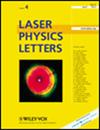The violet laser irradiation influence on the dispersive properties of the PVA/MO composite thick
IF 1.4
4区 物理与天体物理
Q3 OPTICS
引用次数: 0
Abstract
Polyvinyl alcohol (PVA) polymer, methyl orange (MO) and their composite was dissolved in water in order to prepare films with different thickness by casting method. The films were irradiated by a violet laser with a wavelength 405 nm for different times (0, 10, 20, 30 and 40) minute. The dispersion parameters were calculated before and after exposure to the laser using the Wemple–DiDomenico method. Dispersion energy (紫激光辐照对 PVA/MO 复合厚材分散特性的影响
将聚乙烯醇(PVA)聚合物、甲基橙(MO)和它们的复合材料溶于水,用浇铸法制备不同厚度的薄膜。用波长为 405 nm 的紫激光照射薄膜不同的时间(0、10、20、30 和 40 分钟)。使用 Wemple-DiDomenico 方法计算了激光照射前后的分散参数。PVA、MO 和 PVA/MO 厚膜的色散能(Ed)和电子转变的单振荡能(Eo)随着照射时间的增加而增加。这有助于改变材料的几何和光学规格,尤其是在医疗领域的应用。Urbach 能量也可以通过辐照时间来控制,因为它随着激光辐照时间的增加而降低,这可用于增强材料的结构。
本文章由计算机程序翻译,如有差异,请以英文原文为准。
求助全文
约1分钟内获得全文
求助全文
来源期刊

Laser Physics Letters
物理-仪器仪表
CiteScore
3.30
自引率
11.80%
发文量
174
审稿时长
2.4 months
期刊介绍:
Laser Physics Letters encompasses all aspects of laser physics sciences including, inter alia, spectroscopy, quantum electronics, quantum optics, quantum electrodynamics, nonlinear optics, atom optics, quantum computation, quantum information processing and storage, fiber optics and their applications in chemistry, biology, engineering and medicine.
The full list of subject areas covered is as follows:
-physics of lasers-
fibre optics and fibre lasers-
quantum optics and quantum information science-
ultrafast optics and strong-field physics-
nonlinear optics-
physics of cold trapped atoms-
laser methods in chemistry, biology, medicine and ecology-
laser spectroscopy-
novel laser materials and lasers-
optics of nanomaterials-
interaction of laser radiation with matter-
laser interaction with solids-
photonics
 求助内容:
求助内容: 应助结果提醒方式:
应助结果提醒方式:


